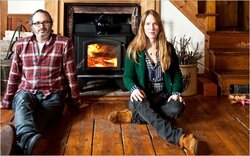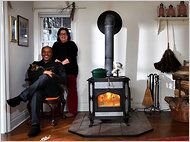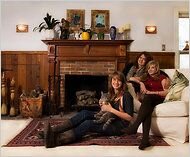Page 2
In any case, most fireplaces are used far too infrequently to cause any real damage to the environment, said Stephen Sears, the vice president of marketing and member services for the Brick Industry Association, voicing an opinion shared by some. In the East, he wrote in an e-mail, air pollution is at its worst in the summer, and in the West the regulations are an overreaction: “Because it is not realistic to test each unique masonry fireplace in a laboratory†to evaluate its emissions, he noted, “it is easier for some municipalities to arbitrarily limit†the use of all wood-burning fireplaces.
Frederica Georgia for The New York Times
Sally Treadwell, with her daughters Natalie, 18, on the floor, and Emma, 14, rarely makes a fire.
Karen Soucy, an associate publisher at a nonprofit environmental magazine, isn’t swayed by that argument. She refuses to enter a home where wood has been burned, even infrequently.
Ms. Soucy, 46, blames fumes from a wood fire for sending her to the emergency room 25 years ago with a severe asthma attack. She had been staying at a friend’s house in Stowe, Vt., for about a day, she said, when her lungs seized up. She was taken to a hospital in an ambulance, and got two shots of adrenalin; the doctors blamed her friend’s cat.
“It was only later, working with a team of allergy doctors and pulmonologists, did we determine the culprit to be the wood-burning fumes from the various fireplaces,†Ms. Soucy said.
Now her husband scouts out any place they go in advance, to be sure it’s free of fireplaces, and she passes up countless dinners and parties. “I’m the one who feels guilty for always being the one to decline invitations or for making people go out of their way to clean their home,†she said. Even then, she added, “the smell lingers on everything.â€
FOR those who still want to build a fire, there are several ways to make it more environmentally friendly, experts say, including using an energy-efficient wood or pellet stove certified by the Environmental Protection Agency or retrofitting a fireplace with an insert (a device, usually made of iron or steel, that fits into the mouth of a fireplace and enables it to heat more efficiently).
Ms. Brown’s and Mr. Arpels’s solution was to install an energy-efficient wood stove in one of the three fireplaces at their farm in Chatham, N.Y. The surrounding countryside is filled with downed trees that would decompose anyway, said Ms. Brown, 38. And Mr. Arpels, 41, gets some exercise from splitting the logs.
“Basically we’re not transporting things using oil from across the world to our house,†she added. “We think this is pretty good, environmentally.â€
Wickham Boyle, 60, a writer and consultant for nonprofit arts organizations, installed a soapstone stove in her Hudson Valley house after a saleswoman explained that it had a catalytic combustor that converts smoke into water and carbon dioxide. Guests sometimes ask her if she feels guilty about burning wood, she said, but she recites a laundry list of the stove’s high-efficiency features, explaining to them that the environmental impact is negligible due to the combustor, and that she mainly uses fallen wood cleared from her land or other properties nearby.
Not everyone can afford such a stove, which can cost upward of $2,000, including installation (Ms. Boyle paid $3,000 for hers).
Converting a wood-burning fireplace to gas can be just as expensive, and while electric fireboxes are cheaper — just a few hundred dollars — most consider them a poor substitute for a real fire, since there is no flame. So some people are simply using their fireplaces less often, or not at all.
Sally Treadwell, a 51-year-old public relations executive in Boone, N.C., said nothing makes her happier than building a fire on a cold winter night. But most of the time she doesn’t, she said, because she feels too guilty about the damage it may do to the environment.
“We’re in the Appalachian Mountains, and I know what pollution does to us all,†Ms. Treadwell said. “I very definitely limit fires. I’d have one every single winter night if I didn’t have some guilt.â€
When she does build a fire, she should use only seasoned dry wood, according to the E.P.A. Web site, because it burns hotter and releases less smoke. And the firewood for sale at the corner deli — or even the wood supplied by a delivery service — might not be seasoned, even if it is advertised as such, said David R. Brown, a public health toxicologist in Connecticut. To ensure that the wood is dry, he added, it should be stored for at least six months before being burned.
There is also the fire-building technique to consider. Most people don’t realize that the fire should be kept hot (with high, visible flames) for the first 20 minutes, Mr. Brown said, so that the chimney will heat up and the smoke will disperse; otherwise, the smoke tends to drift into the house, causing an increased health hazard.
Even the greenest of the green, though, sometimes throw caution to the winds when it comes to wood fires. Sue Duncan, a 52-year-old landscaper in Austin, Tex., uses native drought-tolerant plants in her landscaping work and hasn’t thrown away an aluminum can since 1974, she said. She has installed a programmable thermostat and fluorescent lighting in her 1,600-square-foot house and has a rainwater collection system out back.
But somehow, she still hasn’t gotten around to retrofitting her fireplace. Every time she builds a fire, it causes “inner conflict,†she said. “Itâ™s a guilty pleasure.â€
A version of this article appeared in print on January 20, 2011, on page D1 of the New York edition..





